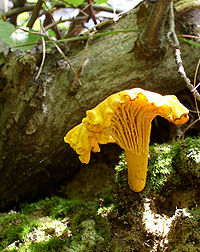- Canthaxanthine
-
Canthaxanthine 
Structure de la canthaxanthine un caroténoïde xanthophylle. Général Nom IUPAC 2,4,4-triméthyl-3-[(1E,3E,5E,7E,9E,11E,13E,15E,17E)-3,7,12,16-tétraméthyl-18-(2,6,6-triméthyl-3-oxo-1-cyclohexényl)octadéca-1,3,5,7,9,11,13,15,17-nonaényl]cyclohex-2-én-1-one Synonymes Orobronze
Carophyll Red
C.I. 40850
C.I. Food Orange 8No CAS No EINECS PubChem No E E161g SMILES InChI Apparence solide Propriétés chimiques Formule brute C40H52O2 [Isomères] Masse molaire[1] 564,8397 ± 0,0362 g·mol-1
C 85,06 %, H 9,28 %, O 5,67 %,Unités du SI & CNTP, sauf indication contraire. La canthaxanthine est un caroténoïde de la famille des xanthophylles, un pigment existant à l'état naturel.
Sommaire
Source
Cette substance a été détectée pour la première fois dans un champignon, la chanterelle (Cantharellus cinnabarinus), avant d'être identifiée dans le plumage et le corps du flamant rose et d'autre oiseaux exotiques comme l'ibis rouge (Guara rubra) et la spatule rosée (Ajaja ajaja). Elle a été aussi détectée dans des crustacés et certains poissons (truite, saumon)[2].
Utilisations
Elle est utilisée comme additif alimentaire, par exemple dans la saucisse de Strasbourg, sous le numéro E161g. Sa formule chimique est C40H52O2.
Elle aussi autorisée dans les aliments pour animaux : poissons (truite et saumons, poule et animaux de compagnie (chat, chien, poisson et oiseau)[3].
Elle sert également d'agent bronzant[4].
Annexes
Notes et références
- Masse molaire calculée d’après Atomic weights of the elements 2007 sur www.chem.qmul.ac.uk.
- (en) International programme on chemical safety - OMS - Toxological Evaluation of some food colours, enzymes, flavour enhancers, thickening agent and certain food additives - Canthaxanthin [lire en ligne (page consultée le 12 mars 2008)]
- (en) Opinion of the Scientific Committee on Animal Nutrition on the use of canthaxanthin in feedingstuffs for salmon and trout, laying hens, and other poultry Adopted on 17 April 2002. [PDF] [lire en ligne (page consultée le 12 mars 2008)]
- BIAM, « Canthaxanthine », 2000. Consulté le 12 mars 2008
Articles connexes
Liens et documents externes
Wikimedia Foundation. 2010.

